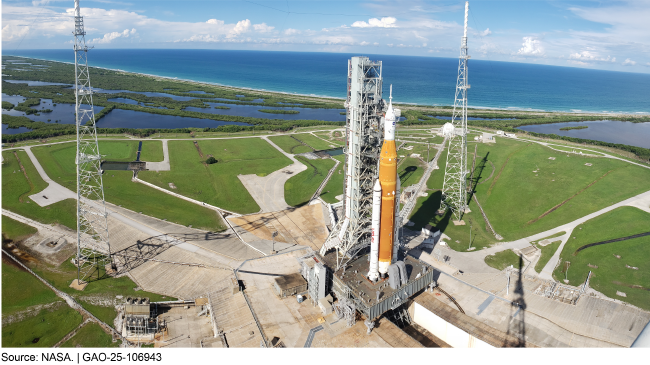NASA Artemis Missions: Exploration Ground Systems Program Could Strengthen Schedule Decisions
Fast Facts
NASA's Artemis missions plan to return astronauts to the moon. The Exploration Ground Systems program develops and operates everything needed to integrate and launch rockets and spacecraft for the missions.
Starting with the 2028 Artemis IV mission, the Mobile Launcher 2 will transport and launch key systems. But the contractor must finish building the launcher first. Then, NASA must test it while completing a large amount of work on other program systems—including some that must be done sequentially. As a result, the launcher's completion is largely driving Artemis IV's schedule.
We recommended NASA analyze the risk for schedule delays.
The integrated Space Launch System and Orion crew capsule atop the Mobile Launcher 1 on the launch pad at Kennedy Space Center

Highlights
What GAO Found
The National Aeronautics and Space Administration (NASA) plans to build a sustained human lunar presence through a series of missions known as Artemis. The Exploration Ground Systems (EGS) program develops and operates the systems and facilities necessary to integrate and launch rockets and spacecraft and then recover crew for the Artemis missions.
Key Exploration Ground Systems Activities for Artemis Missions

The program has made progress, but the Artemis schedule poses challenges.
- Artemis II and III launches (planned for September 2025 and 2026, respectively): EGS is making progress refurbishing the Mobile Launcher 1—the structure used to transport and launch key systems—and modifying elements to support crew during these missions. New capabilities are taking longer than planned, and the program has only limited time to address potential issues.
- Artemis IV launch (planned for September 2028): EGS has made some progress toward this mission, such as modifying facilities to accommodate processing and launching the larger Space Launch System (SLS) Block 1B launch vehicle. However, much work remains, some of which cannot start until after the Artemis III launch.
EGS's Mobile Launcher 2 (ML2) is the primary schedule driver for Artemis IV. While NASA has tools in place to help understand the ML2 contractor's schedule, there is substantial sequential work after the ML2 is delivered that will drive the Artemis IV mission schedule. NASA officials have not committed to conducting a future schedule risk analysis for EGS and ML2. Performing this analysis would provide insight into ML2's readiness for the mission and inform NASA management's resource decisions leading up to integration for Artemis IV.
NASA requires the EGS program to measure operations costs through annual 5-year cost estimates. EGS's most recent estimate from February 2024 stated that its operations will cost about $3.7 billion through fiscal year 2029. Program officials said that they plan to refine their estimating processes based on lessons learned from the first annual update process and apply the lessons to future estimates or to updated guidance.
Why GAO Did This Study
NASA plans to return astronauts to the moon to make new scientific discoveries, generate economic benefits, and inspire a new generation. NASA is planning to spend billions of dollars on the Artemis missions. This includes over $3 billion specifically for EGS from fiscal years 2024 through 2028. The EGS program was a key contributor during the launch of Artemis I in November 2022. The program will support crewed Artemis launches in upcoming years. Since Artemis I, EGS continues to improve facilities and develop capabilities for future Artemis missions, such as the ML2, which will play a critical role for the Artemis IV launch.
A House report includes a provision for GAO to review NASA's human exploration programs, including EGS. GAO's report (1) evaluates the extent to which the EGS program has made progress toward upcoming Artemis missions, including on the ML2, and (2) assesses the extent to which NASA has established plans to measure EGS program costs. To do this work, GAO analyzed program documentation and cost data, conducted a site visit to Kennedy Space Center where EGS is located, and interviewed NASA, EGS, and ML2 officials and contractor representatives.
Recommendations
GAO recommends that the EGS program and the ML2 project conduct at least one schedule risk analysis prior to beginning integration for Artemis IV. NASA partially concurred with this recommendation, which GAO maintains remains valid.
Recommendations for Executive Action
| Agency Affected | Recommendation | Status |
|---|---|---|
| National Aeronautics and Space Administration | The NASA Administrator, in coordination with the Exploration Systems Development Mission Directorate, should ensure that Exploration Ground Systems program and Mobile Launcher 2 project officials perform at least one schedule risk analysis prior to beginning integrated operation activities to support the Artemis IV launch. (Recommendation 1) |
When we confirm what actions the agency has taken in response to this recommendation, we will provide updated information.
|
